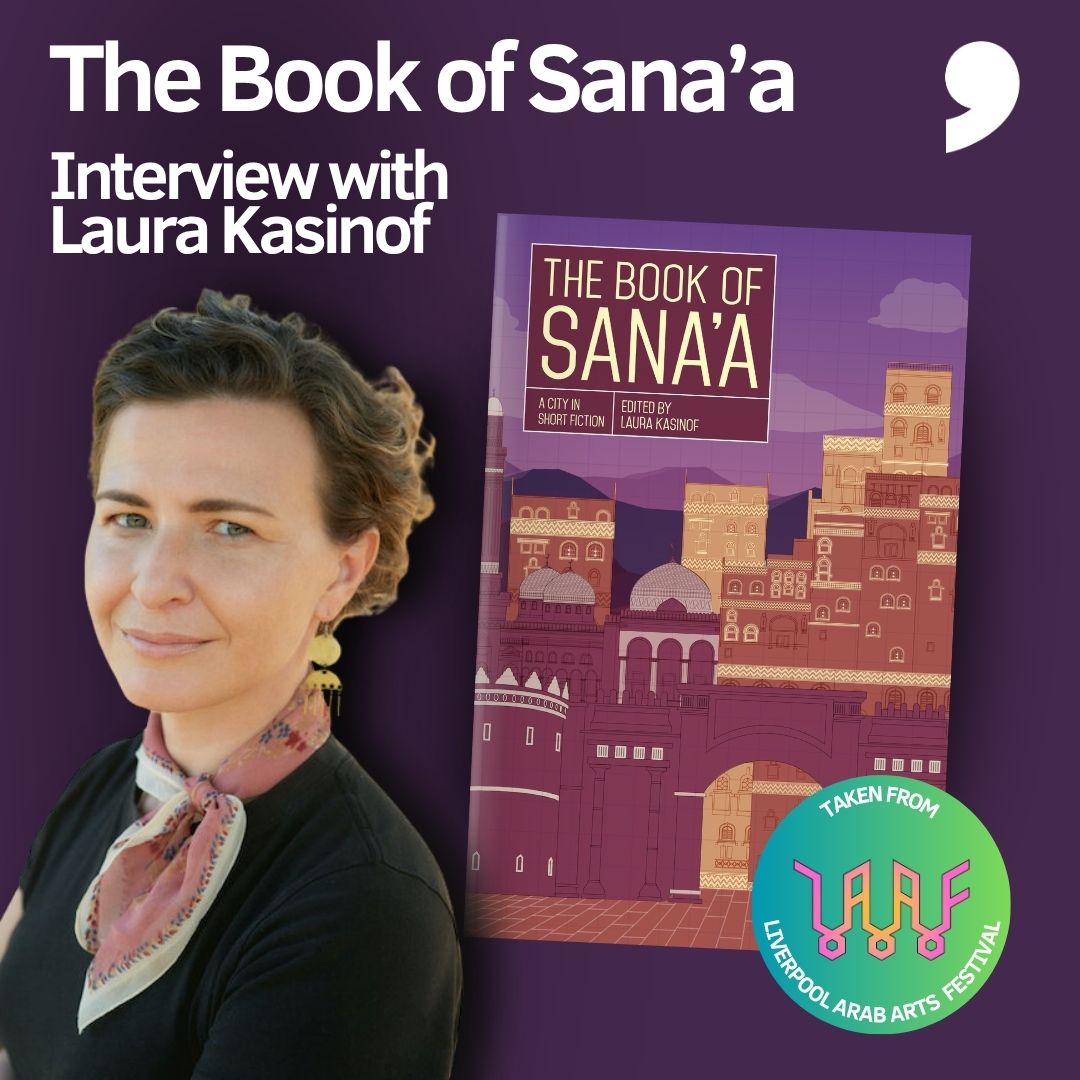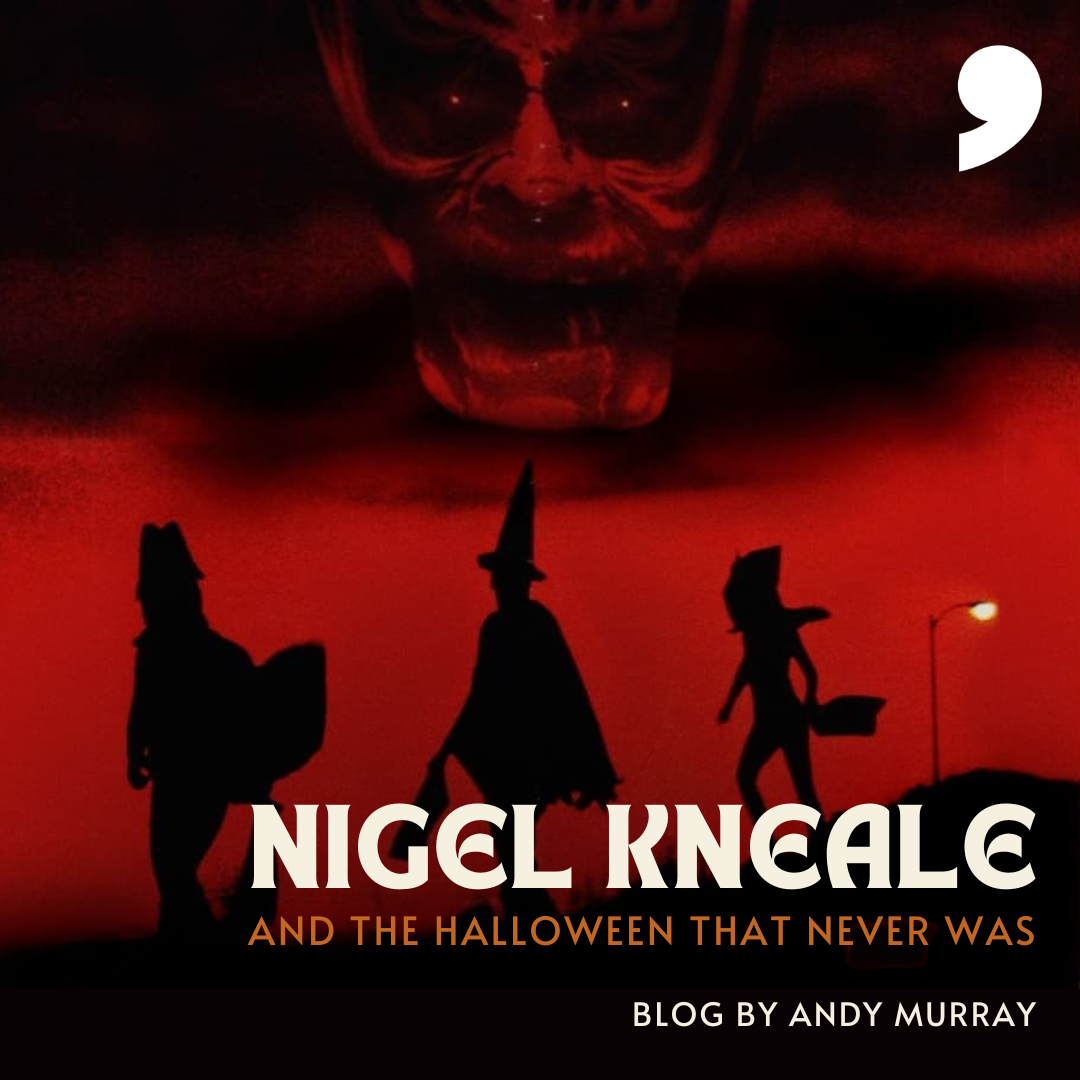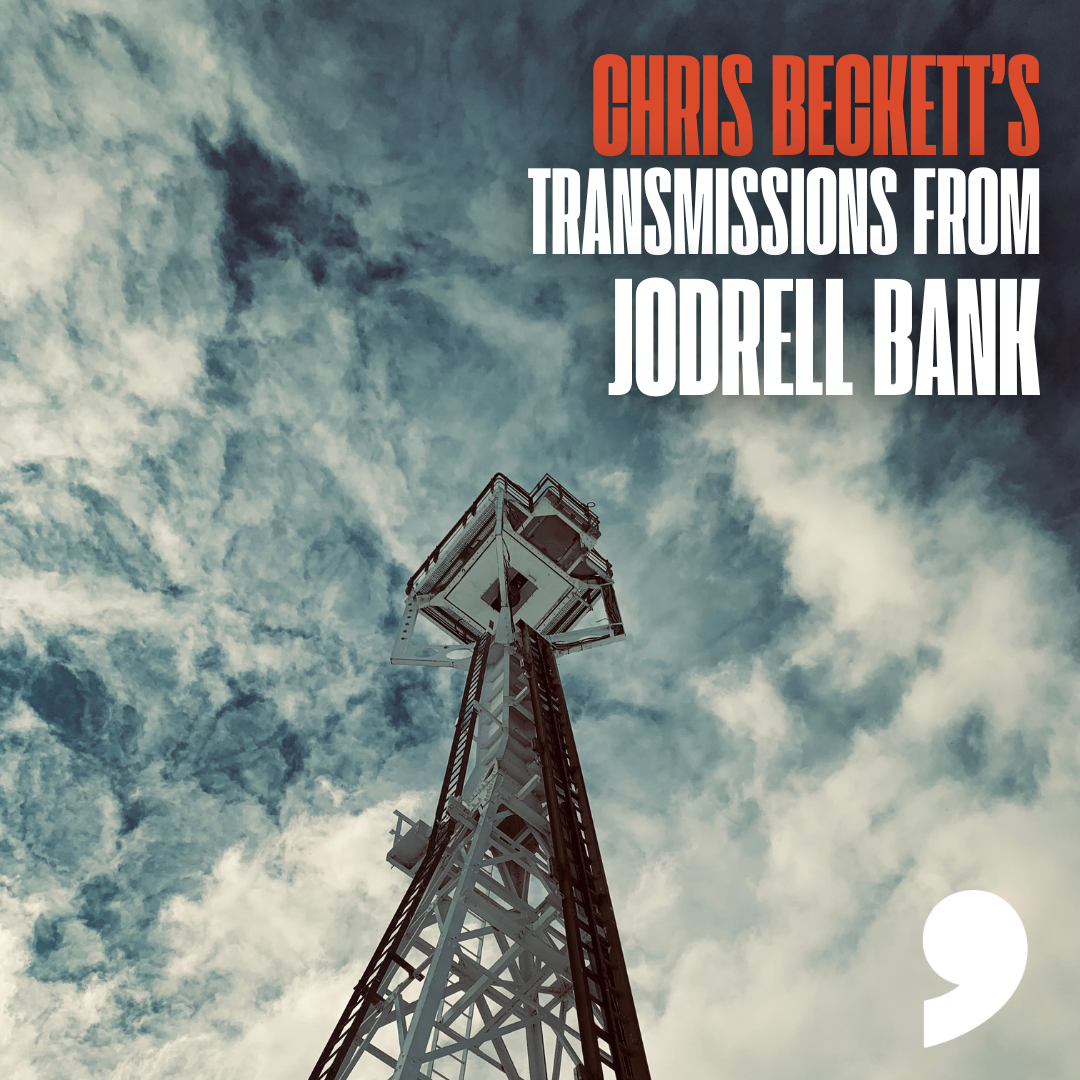The Book of Sana’a: Interview with Laura Kasinof
We sit down with editor of The Book of Sana'a Laura Kasinof, as part of Liverpool Arab Arts Festival, to discus first impressions of the Old City, Yemen's often-overlooked role in the region, and the importance of engaging with a place through fiction.
The following is from an interview between Laura Kasinof and Comma Press founder Ra Page, recorded originally for last week's launch of The Book of Sana'a at Liverpool Arab Arts Festival. You can find out more about LAAF via the link above, and you can order The Book of Sana'a here.
What are some of your first memories of Sana’a?
I remember some specifics pretty well. It was a long time ago, it was 2009. I had lived in Egypt, in Cairo for a few years and had spent some time in Lebanon. So, me as kind of a dumb outsider - you know, you come to Yemen and I knew it would be different, but oh my gosh, it's nothing like these other places. I didn't even know what I was expecting, I think that's the best thing to say.
The plane arrives in the middle of the night and the city is so quiet which is nothing at all like these other big Arab cities that I had spent time in, and then in the day everything changes and it's very loud - with people yelling, the cars, the traffic. So that I remember - that impression. It's a very early-rising city as opposed to a city like Cairo.
But my other first impressions - the air, I think is a big one. I’d never lived at elevation before and Sana’a is over 7,000 feet high, so the air just feels different. It's more crisp, like there's something sort of alive about it.
The colours of Sana’a – the city sits in a valley between these mountains. I've spent time in the Gulf since, but there's something more about Sana’a, the desert mountains, the muted greens of the old city, the stained-glass windows that are everywhere in Yemen, that are traditional northern Yemeni architectural style.
Yemen is the sort of place where as soon as you offer any kind of kindness, it's offered back to you five times more. I think if you come into it with like a hardened stance then people aren't going to open up, but people are so eager to open up. They’re eager to be friendly and eager to show you that friendliness. I'm talking in generalizations, but that sort of warmth is something that strikes you right away.
Why do you think Yemen is so little understood in the west, and only really talked about in the context of wider regional issues, and why has so little Yemeni literature made it into translation?
It’s a complicated question with a lot of different reasons. I mean it's something I wondered myself. One thing I remember since I worked as a reporter in Yemen during the 2011 political uprisings known as the Arab Spring, is that when people would list countries in the Middle East that had experienced the Arab Spring, they would leave Yemen out even though Yemen had had a regime change as a result. Yemen is never the priority for the west, right? Yemen is never the main event. It's not Israel/Palestine, it's not like Iraq and Afghanistan when there's been US troops on the ground. Maybe it has something to do with that. Historically it was never an important political player so it takes a long time, maybe, for attention to catch up because it's obviously becoming more and more important and people are realizing that it always should have been important.
So it was just kind of seen as this state that sat below Saudi Arabia. I think it has also something to do with Yemen's role within the Arab world and the fact that it's also kind of seen as a secondary country there. I lived in Cairo for a while and people would often say derogatory things about Yemenis.
There's so much Yemeni literature - a rich tradition of literature, especially poetry, but short stories and novels as well. But Yemen doesn't have the output to the Western publishing world because it doesn't have big publishing houses there like in Lebanon and Cairo.
Can you talk about some of the historical backdrops to the book?
I think a lot of the stories really span conflict in Sana’a since the start of the republic, the end of the Imamate that ruled Yemen up until the present-day conflict, which was really interesting. We got a lot of stories set in conflicts. One thing that’s interesting — because Yemenis think of Sana’a often, you know, as a city with a lot of conflict in its history. Things are often contextualised in by conflicts: ‘Oh, this was between these wars,’ whereas in other cities in Yemen, we wouldn’t get that.
I believe the oldest story we have — in terms of when it’s set — is during the revolution in Yemen, the revolution against the Imamate. There was war between figures who wanted to overthrow the Imam, who controlled northern Yemen at that time. Yemen was divided between North and South Yemen. South Yemen was a British colony until 1967. The republic came to Yemen in 62 or 63 — I always forget — but it’s set in that war between revolutionaries and the Imamate.
There was some time of relative calm in Sana'a, and then we have many stories set in the Arab Spring years up to the present, or set in the context of Ali Abdullah Saleh's regime and the political absurdities of it. He was the president of North Yemen from the late 70s until 2012 — for 33 years — and ruled Yemen in a way many people think only he could. He was constantly playing games with different tribes and factions but used all of it to benefit himself and his family, not the country. He was very smart in some ways and not very forward-thinking in others.
We have stories set in the absurdities of his regime, the Arab Spring revolution against him, and in the context of the current war — regarding life under the Houthis in Sana'a — which has experienced a serious crackdown on freedoms: speech, women's rights, the freedom to work. There’s a general tenseness — maybe similar to living under Bashar al-Assad in Damascus — in terms of being afraid to talk. You never know when you're going to be arrested, and it could be for anything. So, it really spans Yemen’s modern history, which is quite interesting.
Picking Sana’a as a backdrop for learning about Yemen might seem obvious, but it does come with baggage… why?
Even before the current situation — the Houthis controlling Sana'a and much of northern Yemen — there's a strong emotional divide between the north and south. As I mentioned, Yemen was two countries until 1990. Many Yemeni writers from the south, or from Taiz (a central city in Yemen that was part of North Yemen but is spiritually closer to the south), sometimes feel Sana'a always gets the focus. I have one Yemeni writer friend from Hadhramaut — she's from Mukalla — and when I had this call for Yemeni short stories focused on Sana'a, I felt bad, because there's a feeling of marginalization. After unification in 1990, Ali Abdullah Saleh’s control led to a feeling that northern culture came south and started to take over.
That’s part of the reason for anti-Sana’a sentiment, and it’s increased since the Houthis took over Sana'a. That brought real tension. When you first came to me with the idea for the book of Sanaa', it was a while ago, and at that time, anti-Houthi sentiment was very fresh — especially from Yemenis pushed out of Sana'a. These might be people with a certain political background, or just southerners in general. It’s become more anti-Sana'a because of Houthi expansion, trying to take cities like Taiz and Aden.
So, if I approached people saying, ‘We're doing a book of short stories about Sana’a’ I worried about the political baggage — all the conflict and war. And some people didn’t respond well. But most people — even Yemenis who were pushed out of Sana'a due to free speech issues under the Houthis — were eager to write about Sana’a. At the end of the day, it’s the capital. It has a special feeling. It’s the spiritual heart. People love the Old City — it brings joy. Even if they don’t politically align with the conservative Old City residents who often align with the Houthis — there’s something in their hearts. People were eager to write about it. Even those forced to flee were eager to share stories. That was special. I didn’t need to be as worried as I was about centring the stories around Sana'a.
Tell us about the process of putting these stories together. Did anything surprise you about what came back?
We put out the call for submissions. I sent it wide to contacts, especially those connected to the literary community. I knew many Yemeni journalists, but not many fiction writers — but my journalist friends knew them. One nice thing about Yemen is everyone kind of knows everyone. For a country of 25 million, the urban populations are very connected, so it was easy to get people to look at the submission call.
We got about 50 stories, which was great. I was worried we wouldn’t get enough and that I’d have to beg people to write something — which I didn’t want to do, because these stories should come from the heart. But we got over 50. We originally thought we’d publish 12, 13, or 15 — but we picked 18 because there were so many good ones. That was really special.
We had a selection committee, picked the stories, and had them translated — most were originally in Arabic. Only one was originally in English. We edited the translations. One thing that was interesting: the Yemeni dialect is really hard. Some translators struggled. Some Yemeni editors didn’t even understand certain dialects because they were so hyperlocal. Sometimes one Yemeni editor had to ask another what a phrase meant. That shows how localized language is in Yemen.
Another thing: many stories were sad. That wasn’t surprising, but it meant the book is quite sad overall — and that’s okay. It was still a great experience.
Why is reading about a place through its fiction so important? What can fiction offer that non-fiction can’t?
I read a lot of translated fiction in general, and I find myself drawn to it because I wonder why I’m drawn to it. I think it’s out of general curiosity about the world. It gives me insights into a place or culture that I may have no other way to access. It brings it alive. I mean, it brings it alive in a way that history books or journalism or non-fiction just can’t. They're much more dry and flat. This is much more three-dimensional.
And then, I come at it from a biased angle, but when I really like something—like last night, I reread The Book of Sana—I was just like, wow, this really does feel alive to me. It makes Sana'a come alive, which I find so special. I haven’t been to Sana'a for many years, unfortunately, and I cannot go now.
So, it’s just so vivid. You feel the sounds, the noise, the way people respond. I think the way the dialogue happens there gives an insight into something that can’t come any other way.
For The Book of Sana'a, I think maybe for outsiders it’s a peek into the city that is so special and complicated and messy. It's a way in. But for people who know it, it’s beautiful because it brings it alive. And the stories—they're so different and varied, but each brings it alive in its own way. Sometimes documentaries can do that, or fiction, or narrative film if it's done well. But with fiction, you just see the depth of a place in a way that doesn't happen otherwise.
Maybe you're not going to learn all the facts—boom, boom, boom—but why does that matter? It might matter sometimes, but sometimes it doesn't.
Laura Kasinof is a writer and journalist. She has had the privilege of reporting in a dozen countries across the Middle East, East Africa and Europe. Her work has appeared in the New York Times, Slate, Foreign Policy, Harper’s, the Guardian, the Atlantic, VQR, Guernica and many more publications. It’s been supported by the Pulitzer Center on Crisis Reporting, the Fund for Investigative Journalism and the International Women’s Media Foundation, and has been translated for Italian, Swiss and Japanese press.
Laura’s story for the Virginia Quarterly Review that chronicled the saga of a newly arrived Syrian refugee family in Berlin received a citation from the Overseas Press Club for best magazine reporting on an international story in 2018.
Laura is currently at work on her second book, a biography of former Yemen president Ali Abdullah Saleh, forthcoming from Reaktion.
Her first book is about her experience as the New York Times correspondent in Yemen during the Arab Spring. PRI’s The World named Don’t Be Afraid of the Bullets: An Accidental War Correspondent in Yemen as a top book of 2014 and Kirkus Reviews called it “a moving portrait of life as a war correspondent.”
Buy The Book of Sana’a HERE


